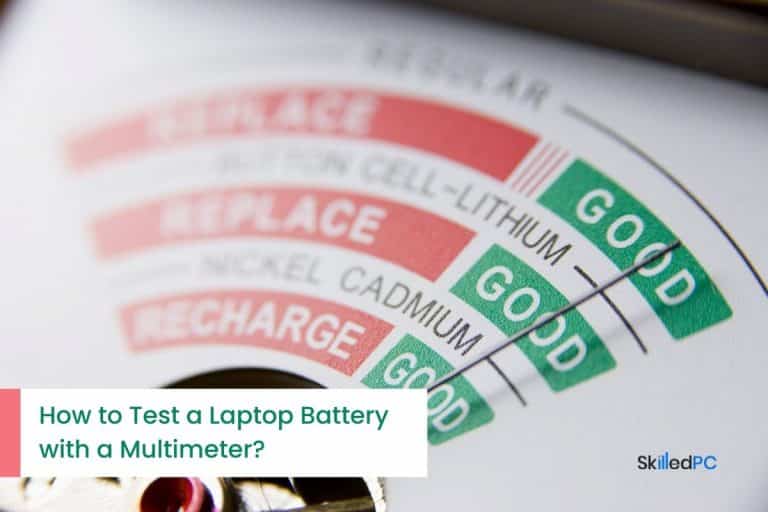As an Amazon Associate, we may earn from qualifying purchases. Our posts may include affiliate links, at no extra cost to you.
Are you worried about your laptop battery health? Do you want to test the battery but don’t know how to do it? We can’t ignore the importance of a laptop battery, as it significantly impacts laptop health, especially if we are professional users.
You can quickly check the laptop battery with a multimeter tool. The battery’s health depends on different factors. However, maintenance is the most important to keep the battery of your best laptop in an ideal state for long-term use. Cutting a long tale short, let’s find out how to test a laptop battery with a multimeter.
Contents
How does the laptop battery work?
There are many differences between the laptop battery and other batteries. Laptop batteries are available in different shapes and sizes. There is a complex electronic circuit that communicates with the hardware and regulates the energy flowing into the battery during charging. The amount of energy pours out of each battery cell during discharge. This feature is not available in standard rechargeable batteries.
Several cells are linked together to create a laptop battery. It connects multiple cells in parallel (negative and positive terminals to each other). It improves the power delivery capacity of the battery but not the voltage.
Also Read: Convert Work Laptop to Personal
How to Test a laptop battery with a multimeter?
The testing laptop battery is one of the most reliable methods. Just follow this easy procedure to check your laptop battery.
- First of all, fully charge the battery.
- Now turn off your laptop and disconnect all devices.
- Remove the battery from the laptop.
- The voltage rating is usually printed on the surface of the battery. Make sure to check it.
- It is better to compare the rating to the multimeter reading.
- Typically, the voltage rating of a laptop battery ranges from 9.6V, 10.8V, 11.1V, or 14.8V. Some laptops may have fewer voltage ratings depending on the battery quality.
- Check the connector that connects the battery to the laptop.
- The interface is usually located on the sides of the battery.
- Check the center of the side that faces the laptop when it inserts and plugs in.
- The interface appears like a series of similar dots, small in size, and reaches the fan vent of the laptop.
- The negative and positive end of the battery locates in the slot in the outermost area.
- Now take the multimeter and set it to the “On” position.
- Adjust the tool to read direct current voltages on the instrument or less than 20V scale.
- Straight lines indicate the direct-current voltage, whereas Wavy lines show the alternative current voltage.
- Insert the multimeter prong into the battery slot and connect the other prong to the connector’s different exterior space.
- It is essential to consider that it is irrelevant whether the negatives or positives match when connecting.
- If you make connections in this way, the voltage sign will change. However, the number or reading will remain constant.
- Remember, it’s the numbers or readings that matter, not the sign on the multimeter.
- Make sure that the prongs are properly in contact with the bare.
- Note down the reading of the multimeter.
- If the laptop battery is healthy and properly working, the multimeter reading should match to the printed value on the surface of the battery.
Repeat the process to ensure battery health.
Useful Charging tips for laptop battery
All laptops don’t have removable batteries for cooling. Also, internal cooling fans degrade after some time. Here are some useful charging tips for your laptop battery.
- Don’t completely discharge the battery after charging it. It is wise to maintain the laptop battery percentage between 40% to 80%.
- Make sure the laptop doesn’t overheat, and the cooling fan is working properly. The laptop battery may overcharge and damage due to excessive charging.
- Batteries with a full charge have a maximum discharge cycle of 300-500. When charged to 80%, they receive about the quadruple number of recharging cycles.
- Make sure to disable unused ports and devices and select battery-saving mode to reduce the power consumption of the laptop and increase battery backup.
Also Read: Convert Your Old Laptop into a New one
Also Read: Is Laptop Cooling Stand Worthful?
Wrap Up
Remember, the laptop automatically turns off when the storm is discharged completely. It is due to the fact that using a battery below the predetermined voltage level can adversely affect it. Typically, a laptop battery lasts up to 5 years depending on your usage and maintenance. However, it is recommended to test the battery with a multimeter after 3-4 months to avoid inconvenience.






